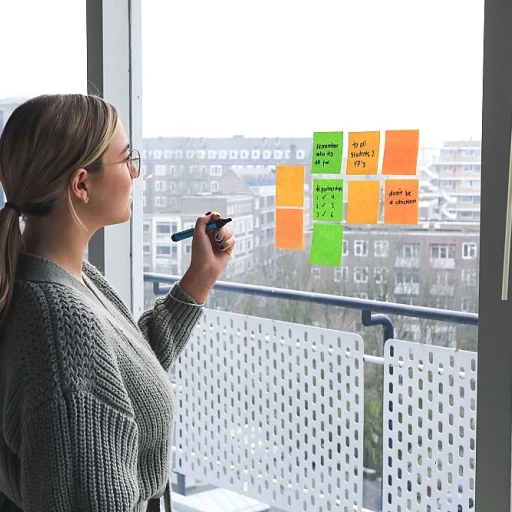
Understanding the Role of People in Continuous Learning
Understanding the importance of individuals in learning environments
The effectiveness of continuous learning within an organization primarily begins with understanding the pivotal role people play in this journey. No matter the structure of the business, people form the backbone of the learning process, influencing how new ideas are accepted, adapted, and ultimately integrated into the company's framework.
Each person, from the management team to the frontline employees, shapes the success of continuous learning initiatives. Ensuring everyone is aligned in their mindset towards growth and development is crucial. This alignment helps organizations build a culture where learning is celebrated and actively pursued, and where success becomes a shared objective.
Moreover, having a skilled team committed to evolving business practices is essential. Management practices that prioritize change management and proactive decision-making foster an environment where continuous improvement is not only possible but expected.
By focusing on individual development, businesses can optimize their learning strategies, ensuring everyone from the product development teams to customer service representatives is motivated and equipped to contribute to the organization's growth.
This interconnectedness between people and processes is further explored when examining how empowering leadership within the framework of a company can enhance both individual and collective success.
Streamlining Processes for Effective Learning
Optimizing Processes for a Seamless Learning Experience
Streamlining processes within an organization is essential for effective continuous learning. By refining these processes, businesses can create a nurturing environment that supports both individuals and teams in enhancing their skills and knowledge.- Framework and Structures: Implementing a well-defined framework is crucial for efficient process management. This ppp framework can help businesses align their people, process, and product development strategies towards common organizational goals. Companies can use structured decision-making approaches to identify gaps and areas for improvement.
- Technology Integration: Leveraging process technology can significantly enhance learning efficiency. By utilizing advanced tools, businesses can facilitate easier access to learning resources and ensure seamless product development. Technology can also help in tracking progress and measuring outcomes effectively.
- Effective Change Management: Change management plays a critical role in smoothly transitioning teams through new learning initiatives. By preparing employees for upcoming changes in processes, organizations can foster a positive learning culture and overcome resistance to new approaches.
Leveraging Products to Enhance Learning Outcomes
Harnessing the Power of Technology and Products
Continuous learning within a business context thrives on the effective use of technology and products. Organizations must strategically invest in the right tools that can drive learning outcomes and propel project management to new heights. Utilizing advanced learning management systems or leveraging cloud-based platforms can significantly enhance the learning experience for both individuals and teams. A well-structured framework is essential to ensure that technology and products serve the intended purpose. Integrating a robust ppp framework – which aligns people, process, and product – can create a harmonious interplay that fosters a culture of continuous learning. Companies should prioritize selecting products that seamlessly integrate with their processes and cater to their specific needs. This integration can support efficient workflow management, resulting in improved decision making and better change management. It is critical for businesses to understand the role that product service plays in their learning strategy. Offering tailored learning products or services will cater to the unique needs of each team member, enhancing both individual and team development. Moreover, companies should recognize the importance of keeping their product development aligned with the evolving needs of their workforce. By doing so, they are better positioned to drive business success and customer satisfaction. The utilization of products and technology not only assists in streamlining learning processes but also builds an adaptable framework that is prepared for future advancements. To delve deeper into strategic approaches in product management within continuous learning, you might find this article on crafting a seamless CTO succession plan helpful: read more.Balancing People, Process, and Product for Optimal Learning
Harmonizing People, Process, and Product for Enhanced Learning
In the landscape of continuous learning, the harmonization between people, processes, and products is critical for achieving organizational success. By thoughtfully integrating each component, businesses can foster a productive learning environment that supports innovation and adaptability. The importance of bringing people into the fold cannot be overstated. People are the driving force behind any successful project or initiative. Their skills, creativity, and collaboration potential are pivotal in ensuring that learning processes are engaging and impactful. Teams that are effectively managed and motivated create a culture of continuous improvement, which is essential for both the individual and the organization’s growth. Processes serve as the framework through which learning initiatives are systematically delivered. By streamlining these processes, companies can facilitate smoother learning experiences that resonate with employees’ needs and organizational objectives. Clear processes not only enhance efficiency but also ensure consistency in delivering learning outcomes, which are vital for sustained success. Products, in the context of learning, refer to the tools, technologies, and resources utilized to support educational objectives. Leveraging the right products can greatly enhance the learning journey by making it more interactive, accessible, and tailored to individual needs. From cutting-edge learning management systems to interactive digital content, the choice of products significantly impacts the effectiveness of the learning process. Balancing these elements requires a comprehensive approach where the people, process, and product components are aligned with the company's goals. Successful balancing acts as a catalyst for change management and decision making, driving business success in a competitive landscape. Moreover, integrating best practices from project management and change management helps ensure the smooth transition to new learning environments, ultimately benefiting the organization and its people. In practice, companies that excel in continuous learning often employ a strategic "people process" or "ppp framework." This approach recognizes that by optimizing each element and understanding their interdependencies, organizations can build robust learning ecosystems. This harmonization not only leads to immediate benefits such as increased productivity and employee satisfaction but also enables long-term adaptation to evolving market demands and customer expectations. Through thoughtful management of people, processes, and products, organizations will cultivate a dynamic "people product" environment conducive to sustained growth and innovation. As continuous learning becomes increasingly important in today’s fast-paced business world, understanding and fine-tuning this balance becomes a dominant factor for enduring success.Overcoming Challenges in Continuous Learning
Facing the Challenges in Continuous Learning
In the dynamic landscape of continuous learning, businesses and organizations encounter a myriad of challenges. These obstacles can inhibit growth unless addressed with strategic solutions. One of the primary challenges includes managing the people aspect effectively. In an organization, aligning individual learning goals with organizational objectives requires thoughtful coordination. It involves engaging the workforce to foster a culture of continuous improvement. Encouraging people to evolve their skills is fundamental, yet resistance to change can hinder this process. Managing processes is another significant hurdle. Streamlined processes are essential for effective learning, but often these can become cluttered with redundant steps and outdated practices. This requires a structured approach to identify and reform inefficient workflows, ensuring they support both product development and people growth initiatives. Technological advancements, while beneficial, also pose a challenge. Integrating new technologies requires investment, training, and a clear understanding of how they will improve learning outcomes. Organizations must balance investment in technology with the tangible benefits it brings to the learning processes. Moreover, decision-making can be complex within teams and projects. Leaders often have to juggle between fostering individual growth and achieving business success. Building a robust framework, like the ppp framework (People, Process, Product), can aid in aligning these aspects systematically, yet its implementation can be challenging without comprehensive change management. To address these hurdles effectively, businesses must implement best practices in project management and leverage the collective expertise within their teams to overcome resistance. Adopting a cohesive strategy that addresses people processes, process management, and leveraging suitable products can guide organizations towards sustainable learning environments. As continuous learning becomes integral to achieving business success, overcoming these challenges is crucial for maintaining competitive advantage in an ever-evolving market environment.Future Trends in Continuous Learning
Embracing Technological Advancements
As we look to the future, technology continues to play a pivotal role in continuous learning. Organizations are increasingly leveraging advanced tools to enhance their learning processes. From AI-driven analytics to virtual reality simulations, technology is reshaping how teams and individuals acquire new skills. Businesses that integrate these innovations into their learning frameworks can expect to see significant improvements in both efficiency and effectiveness.
Adapting to Changing Workforce Dynamics
The modern workforce is evolving, with remote work and flexible schedules becoming more prevalent. This shift requires a reevaluation of traditional learning models. Companies must adapt by creating more personalized and accessible learning experiences that cater to diverse work environments. By doing so, they can ensure that their teams remain engaged and motivated, ultimately driving business success.
Fostering a Culture of Continuous Improvement
Future trends in continuous learning emphasize the importance of cultivating a culture that values ongoing development. Organizations should encourage a mindset of continuous improvement, where employees are motivated to seek out new knowledge and skills. This involves not only providing access to learning resources but also recognizing and rewarding efforts to grow and innovate.
Integrating People, Processes, and Products
To stay competitive, businesses must find the right balance between people, processes, and products. This involves aligning learning initiatives with organizational goals and ensuring that all elements work harmoniously. By doing so, companies can create a robust learning ecosystem that supports both individual and collective growth.
Navigating Challenges with Strategic Planning
While the future of continuous learning holds great promise, it also presents challenges. Organizations must be prepared to navigate these obstacles through strategic planning and effective change management. By anticipating potential hurdles and developing proactive solutions, businesses can maintain their momentum and continue to thrive in an ever-changing landscape.












